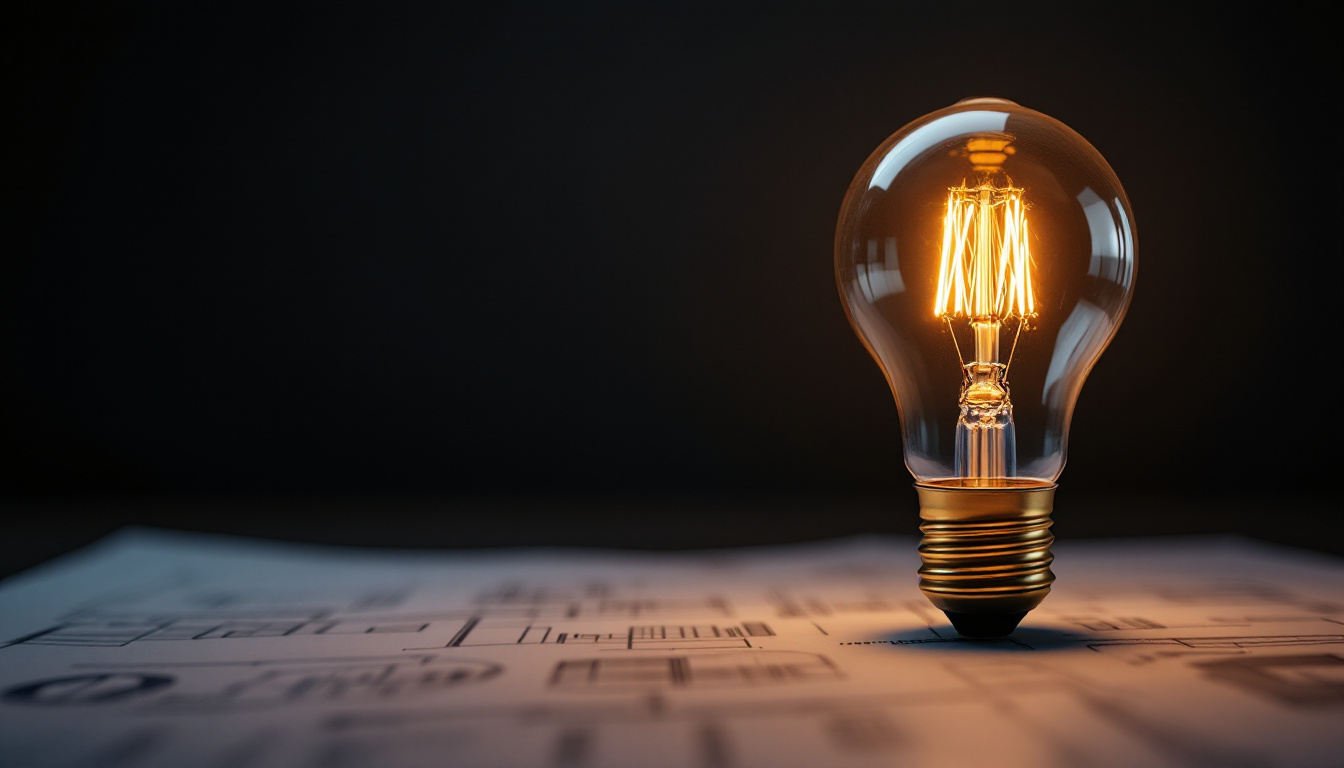
When it comes to the world of lighting, the invention of the light bulb stands as a monumental achievement that has transformed not only how we illuminate our spaces but also how lighting contractors operate within the industry. Understanding the history and evolution of the light bulb can provide valuable insights for contractors looking to secure more contracts and enhance their service offerings.
Before delving into the specifics of the light bulb’s invention, it is essential to understand the context of lighting technology’s evolution. For centuries, humans relied on natural light during the day and various forms of fire, such as candles and oil lamps, to illuminate their surroundings at night. These methods, while effective to some extent, were limited in efficiency and safety. The flickering flames of candles and the smoky residue of oil lamps not only posed health risks but also restricted the activities that could be performed after sunset, often confining people to their homes as darkness fell.
The transition from these primitive forms of lighting to electric light sources marked a significant turning point in the history of illumination. The advent of electricity opened the door for innovations that would eventually lead to the development of the modern light bulb. This shift not only changed how people lived and worked but also created new opportunities for contractors in the lighting industry. With the introduction of electric lighting, public spaces transformed dramatically; streets became safer and more accessible, and businesses could extend their hours, leading to a bustling nightlife that had previously been impossible.
Before electric light bulbs became commonplace, gas lighting was the primary source of illumination in urban areas. Gas lamps, which utilized combustible gas, provided a brighter and more reliable light than candles or oil lamps. However, they also posed significant safety risks, including fire hazards and the potential for gas leaks. The presence of gas lines in cities required a new level of infrastructure and maintenance, which was a double-edged sword; while it created jobs and economic opportunities, it also necessitated a heightened awareness of safety protocols to prevent catastrophic accidents.
As cities expanded and the demand for reliable lighting grew, the limitations of gas lighting became increasingly apparent. This scenario set the stage for the introduction of electric lighting, which promised not only greater safety but also enhanced efficiency. For lighting contractors, this transition represented a pivotal moment, as it opened up new avenues for business and innovation. The shift also sparked a cultural change, as electric lighting allowed for the design of more complex architectural features and public spaces, leading to a new aesthetic in urban planning that emphasized visibility and safety.
The invention of the electric light bulb was the culmination of numerous experiments and advancements in electrical engineering. Various inventors contributed to the development of the light bulb, each building on the work of their predecessors. Early prototypes utilized different materials and designs, but it was the combination of a vacuum-sealed glass bulb and a filament that ultimately led to the creation of a practical and long-lasting light source. This innovation not only revolutionized home lighting but also had profound implications for industries reliant on consistent illumination, such as manufacturing and retail.
This breakthrough not only changed the way people illuminated their homes and businesses but also established a new standard for lighting. For contractors, this innovation meant the opportunity to offer clients a more efficient and versatile lighting solution, paving the way for modern electrical installations. The introduction of the electric light bulb also ignited a wave of creativity among designers and architects, who began to explore new possibilities in lighting design, leading to the development of decorative fixtures that enhanced both functionality and aesthetics in a variety of settings. As electric light became more accessible, it reshaped social interactions and activities, allowing for gatherings and events that extended well into the night, thus altering the fabric of daily life.
For lighting contractors, having a deep understanding of light bulb technology is crucial for several reasons. Knowledge of different types of bulbs, their applications, and their energy efficiency can significantly impact the services offered to clients. Additionally, staying informed about advancements in lighting technology can help contractors remain competitive in an ever-evolving market.
Today, a variety of light bulbs are available, each with its unique features and benefits. Understanding these differences is essential for contractors who want to provide tailored solutions to their clients. Common types of light bulbs include:
By understanding the nuances of each type of bulb, contractors can make informed recommendations to clients, ensuring they choose the right lighting solutions for their specific needs. For instance, while incandescent bulbs may be favored for their warm glow in residential settings, contractors might suggest LEDs for commercial spaces where energy savings and longevity are paramount. Moreover, understanding the color temperature of bulbs can help in creating the desired ambiance, whether it’s a cozy home environment or a bright, focused workspace.
As energy efficiency becomes a priority for homeowners and businesses alike, contractors must be well-versed in sustainable lighting options. The shift towards energy-efficient lighting solutions, such as LEDs, not only benefits the environment but also helps clients reduce their energy bills.
Contractors who can effectively communicate the advantages of energy-efficient lighting will likely find themselves in higher demand. Providing information on energy savings, rebates, and the long-term benefits of sustainable lighting can give contractors a competitive edge in the market. Furthermore, many clients are becoming increasingly aware of their carbon footprints and are actively seeking ways to reduce them. By offering comprehensive consultations that include energy audits and recommendations for lighting upgrades, contractors can position themselves as trusted advisors in the realm of sustainable practices. This proactive approach not only enhances client relationships but also fosters a commitment to environmental stewardship, aligning the contractor’s services with the values of a growing number of eco-conscious consumers.
In an industry that is constantly evolving, staying ahead of the curve is essential for lighting contractors. Embracing new technologies and trends can lead to increased business opportunities and enhanced client satisfaction.
The rise of smart technology has revolutionized the lighting industry. Smart lighting solutions allow users to control their lighting remotely, adjust brightness, and even change colors through smartphone apps or voice commands. This level of customization appeals to modern consumers who value convenience and flexibility.
Contractors who offer smart lighting installations can attract a tech-savvy clientele and differentiate themselves from competitors. Additionally, understanding how to integrate smart lighting with other home automation systems can further enhance service offerings.
lighting design trends are continually evolving, influenced by changes in interior design, architecture, and consumer preferences. Staying informed about current trends can help contractors provide clients with innovative and aesthetically pleasing lighting solutions.
From minimalist designs to statement fixtures, understanding the latest trends allows contractors to create customized lighting plans that align with their clients’ visions. This expertise can lead to repeat business and referrals, as satisfied clients are more likely to recommend contractors who deliver exceptional results.
In the competitive landscape of lighting contracting, building strong relationships with clients is paramount. Trust and communication are essential components of successful partnerships, and contractors who prioritize these aspects are more likely to win and retain contracts.
Clear and effective communication is vital throughout the entire project lifecycle. From the initial consultation to project completion, contractors should keep clients informed about timelines, costs, and any potential challenges that may arise.
Establishing open lines of communication fosters trust and ensures that clients feel valued and heard. This approach can lead to increased customer satisfaction and a higher likelihood of repeat business.
Exceptional customer service is a key differentiator in the lighting contracting industry. Contractors who go above and beyond to meet client needs and expectations are more likely to earn positive reviews and referrals.
Offering post-installation support, addressing any concerns promptly, and being available for follow-up consultations can significantly enhance the client experience. Satisfied clients are not only more likely to return for future projects but also to recommend the contractor to friends and family.
The invention of the light bulb marked a significant turning point in the history of illumination and continues to influence the lighting industry today. For contractors, understanding the evolution of lighting technology, staying informed about advancements, and building strong client relationships are essential for success in a competitive market.
As the industry evolves, embracing new technologies and trends will be crucial for contractors looking to secure more contracts and grow their businesses. By prioritizing energy efficiency, smart lighting solutions, and exceptional customer service, lighting contractors can position themselves as leaders in the field, ready to meet the demands of a changing market.
Ultimately, the key to winning more lighting contracts lies in the ability to adapt, innovate, and provide clients with the best possible solutions for their lighting needs. With a solid foundation of knowledge and a commitment to excellence, contractors can illuminate their path to success in the lighting industry.
Ready to take your lighting contracts to the next level? At LumenWholesale, we provide the essential edge you need in the competitive lighting industry. Our commitment to quality and affordability ensures that you have access to the best spec-grade lighting products at wholesale prices that simply can’t be beaten. Say goodbye to middleman markups and hello to a vast selection of reliable, high-performance lighting that meets the highest industry standards. Plus, with free shipping on bulk orders, you can stock up on premium lighting solutions without worrying about hidden fees or compromises. Elevate your business and delight your clients by choosing LumenWholesale for all your lighting needs. Discover the perfect blend of quality, affordability, and convenience today by visiting Wholesale Lighting at the Best Value.

Discover essential strategies and innovative techniques for lighting contractors in Lot V.

Illuminate your garage workspace with expert insights from lighting contractors.

Discover why purchasing architectural grid mount lights in bulk from local distributors might not be the best choice.

Discover why outdoor lighting fixtures with dusk-to-dawn sensors are essential for any successful lighting project.